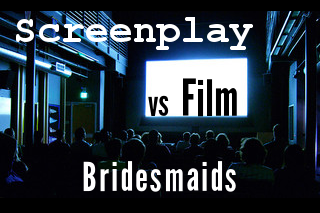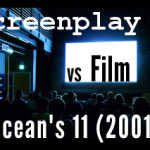Some time ago, let’s not look at the date, I wrote about comedy writing secrets I learned by watching Bridesmaids, the raunchy gag fest penned by Annie Mumulo and Kristen Wiig, who also starred in the the movie as Annie, the Maid of Honor who gets into a down-and-dirty competition with another bridesmaid, Helen, as Annie’s friendship with the bride slowly unravels.
I wrote those humor secrets just by watching the movie, not by comparing a screenplay draft of Bridesmaids to the produced version which hit theaters. When I did read a screenplay draft of the film, I discovered there were tons of differences between the two, making Bridesmaids ripe for analysis for the Screenplay vs Film feature of Scribe Meets World.
While the screenplay draft I read, dated August 2009, came across more like an extended Saturday Night Live skit than a polished screenplay, it definitely sparkled with potential. Despite its roughness, I felt I was in capable screenwriting hands. The movie version, which was heavily influenced by Judd Apatow’s input, is a different beast altogether. It’s funnier. It’s more cohesive. It’s fairer to the characters. Its structure is more solid.
The plot, the subplots, even the organization of the comic set pieces were refined in such a way that the movie became more than a lark written by two funny gals. It became something special. (Not to mention a huge blockbuster and an Oscar-nominee.) So without further ado, here is the first part of the screenwriting tips I learned by comparing the August 2009 draft of Bridesmaids draft to the DVD version (the unrated cut) of the movie:
Screenwriting Tip #1: Character is revealed through habit
The Bridesmaids screenplay begins very similarly to the what we saw in the movie: Annie trying to pretend to jerkwad Ted, played very well by John Hamm, that she looks like a million bucks when she wakes up the morning after. Interestingly, however, in the screenplay, Annie and Ted were on a first date.
In the movie, it was clear by the way Annie and Ted interacted with each other that Annie had been involved in this unhealthy pseudo-relationship for quite some time–and in fact, it was a pattern for her to hook-up with Ted, even though he was not worthy of her. This set up reveals so much more about Annie’s character because it’s a pattern, a habit. It quickly communicated that Annie regularly made bad choices out of poor self-esteem.
You can argue that sleeping with a jerk on a first date also shows that Annie has poor self-esteem, and you’d be right. But a one-time choice doesn’t reveal as much about a character to an audience as a longstanding habit. To show that Annie’s decision to sleep with jerks is a regular pattern, you’d have to show her on more than one date, making the same bad decision. But why write three separate scenes, when just one will do?
While we’re on the topic of Annie and Ted…
Screenwriting Tip #2: Don’t waste the Hamm
If you’ve read a few screenplay writing books, you’ve probably come across the advice to condense multiple characters with small roles into one character. In the process of condensing all of these roles into one, the resulting character usually ends up having more depth, and seems like a real, three-dimensional human being instead of a fictional person.
This advice holds especially true when you snag an awesome actor like John Hamm. You want to give him as many lines and scenes as you possibly can. If you get an actor like John Hamm to sign on to your movie, you don’t want to split his screen time with some lesser-known dude.
So how do you do it?
When you’re writing a screenplay draft, how do you fuse a few characters into one person? When you’re in the production stage of your movie, and you have someone like John Hamm on board, how do you revise your script to take advantage of your windfall? Bridesmaids has an answer.
In the Bridesmaids screenplay, Ted was a bad first date, but not Annie’s only bad first date. She was set up with a jerk named Mike, and she also hooked up with a frat boy at Lillian’s bachelorette party (more on that comedy gag in part two).
In the Bridesmaids movie, both Mike and the frat boy are gone. Instead, they’ve been replaced by more on-screen interactions between Annie and Ted…which makes better use of John Hamm’s casting (and is better way to show Annie’s habit of seeking out Ted when she’s feeling low.)
Screenwriting Tip #3: Your characters need to be in a position “to talk to the hand”
Basically, that’s my cheesy way of saying that it is much more preferable to have your characters interact with each other in person, not over the phone (or via email, text, Twitter, or whatever new technology emerges in the next couple of years). When actors are in the same physical space, they can play off of one another. Don’t deprive them of this opportunity!
In the screenplay draft of Bridesmaids, several key conversations were done over the phone instead of face-to-face. After Annie sleeps with Ted, she calls her best friend Lillian to confide her shame. In the movie, they nixed the phone conversation and opted for Annie and Lillian to meet in person, a much better screenwriting choice. Their witty in-person exchanges clearly telegraphed the depth of their friendship in a way the phone conversation never could. Their camaraderie was so firmly established at the beginning of the movie, that it eliminated a lot of unnecessary dialogue and one extraneous flashback, greatly improving the movie’s pacing. Here’s a clip of Annie and Lillian from the beginning of Bridesmaids:
Another example: in the screenplay, Annie met Helen for the first time via telephone. It was a four page, dialogue-heavy scene. While Annie was talking to Helen, she was standing by a magazine stand, unsuccessfully flirting with another bystander.
It’s certainly not a bad scene, but it felt like a comedy sketch…not the set up necessary to establish a rivalry which is the engine for the entire screenplay. Since this dynamic plays such a crucial role in the plot, Helen and Annie’s first interaction warrants more than a phone conversation. Their first interaction should be in person…just like the way it was in the movie.
When Annie meets Helen for the first time at Lillian’s engagement party, Helen is designer gown perfection, while Annie’s costume jewelry cute. Annie’s wide-eyed dismay, Helen’s gushing smiles, and Lillian’s innocent contentment conveyed everything we needed to know. This set up was quick, efficient, and good screenwriting. In contrast, the phone call between Annie and Helen was clunky, unnecessary, and a waste of limited screenplay pages.
Go through the most recent draft of the screenplay you’re writing and find all the conversations which take place over the telephone. See if you can replace them with a face-to-face conversation, where one character could literally put her hand in the other character’s face. These scenes are harder to write than phone conversations, especially if you have to spend a little screenplay real estate setting up the in-person interaction, but your screenplay will be all the better for it.
Note: not every phone conversation has to be eliminated. In both the Bridesmaids screenplay and movie, there’s a sequence where Annie tries to convince the other bridesmaids to host Lillian’s bachelorette party at a rustic cabin, but they all want to go to Vegas instead. Intercutting all their phone conversations was a key element of the humor.
If all the bridesmaids had been gathered together, talking over one another, it wouldn’t have been as funny. And of course, there’s the Queen Bee of all phone calls, the three-way work of art in Mean Girls.
Screenwriting Tip #4: Show, don’t tell
This is a screenwriting tenet you hear all the time. Whether you’re an amateur or a professional screenwriter, it’s so easy to fall into the telling-not-showing trap. Here are a few on-the-nose dialogues from the Bridesmaids screenplay, intended to convey Annie and Lillian’s friendship and that Annie was nervous about being a good Maid of Honor to her friend:
Example #1: When Lillian asks Annie to be her Maid of Honor
LILLIAN
It’s no big deal, and I don’t want to make it one. It’s not gonna be a big, crazy thing. I wanna keep it simple.
(beat)
What dessert are you gonna get?
ANNIE
I know what you’re doing. Don’t downplay this. I’m happy for you. And someday when hell freezes over, you can be my Maid of Honor. But for right now, this is about you. OK? This is your day, and it is a big deal.
Example #2: When Laurie, Lillian’s mother, introduces Annie to a friend of hers
LAURIE
It’s worth it, though, huh? Mary, I want you to meet Lillian’s Maid of Honor.
MARY
Oh, very special job.
LAURIE
This is Annie Walker. She lived next door to us in Milwaukee until the girls graduated from high school.
ANNIE
Hi.
Annie leaves.
LAURIE
Her father ran off to Florida with a younger woman who was working at a Chrysler dealership.
MARY
Oh my.
LAURIE
Poor Judy, never quite got over it. She also ended up moving to Florida to take care of her parents.
MARY
Oh, that is tough. Well it’s nice Annie and Lillian have stayed friends.
LAURIE
They’re like sisters.
Example #3: When Annie chats with her boss, a woman named Donna
ANNIE
Sorry…well, it’s official. Lillian just set a date. October tenth. Why did I just get a stomach ache?
DONNA
Don’t be nervous, It’s not all on your shoulders. Doesn’t she have other bridesmaids?
ANNIE
Yeah, and they’ve all done this before so I’m feeling a little pressure. I have to make this really nice for Lillian.
All of these dialogues were unnecessary.
As I mentioned in screenwriting tip #3, Annie and Lilian’s friendship was established early on by the way they joked together in the café. That one scene was all that was needed. Other scenes show us that Annie’s worried about her Maid of Honor duties. She doesn’t have to tell us too. The scene with Laurie and Mary is particularly a waste of screenplay real estate–we never see those two ladies again!
The hardest thing about the showing vs telling rule is that it can be difficult to identify all times you’ve yielded to the temptation of telling. Reviewing these examples from Bridesmaids, as well as the ones from the Hangover and 10 Things I Hate About You should develop your ability to detect when you’ve fallen into the dark pit of telling.
When you’re revising your own screenplay, remember: SHOW it once, show it well, and have faith that the audience will get it.
Screenwriting Tip #5: Set pieces require structure
When I wrote the article about comedy writing secrets I learned by watching Bridesmaids, I didn’t realize that the toasting competition between Annie and Helen at Lillian’s engagement party wasn’t scripted precisely that way in the screenplay. In the screenplay, Helen gave an incredibly touching toast, complete with an inside joke about drunken nights at Rockin’ Sushi and pointed barbs about being Lillian’s best friend.
Annie tried to outdo Helen’s toast, but the the scene didn’t have the structure that the movie scene did. In the movie, Annie and Helen competed on specific elements: first in length, then in their foreign language ability, and finally in their vocal talent. Each “round” of competition built up the humor. This structure turned a funny skit into a seriously comic set piece.
In the screenplay, all those jokes were jumbled together in Annie’s speech:
The room falls silent as she [Annie] walks up to the podium.
ANNIE
Uhm, hello everybody. Hi everyone. I’m Annie. Wow, it really smells like vanilla in here.
MEGAN
It’s the candles Annie.
ANNIE
Thanks Megan. Lillian, this is gonna be awesome. Um, uh, God, oh, oh, oh, what’s that saying? It’s a good one, a good saying, it’s Irish. It’s a-like a toast. Is it Irish? Something about a road…Oh God, I’m blanking. So I’ll just say I’m so happy to be a part of this whole celebration and happiness. You two are so happy together and hope you have a happy lifetime of happiness and celebrating. And I love you and…Lillian, we’ve been best friends since we were like five…I’ve never been to Greece…
Annie laughs nervously. Some people clap, they don’t know if she’s done. Annie sees Helen has moved over to sit next to Lillian.
ANNIE (SINGING)
[song lyrics]
Some people reluctantly sing along.
ANNIE
[song lyrics]
So you could see the difference, I tried to find a clip of the toasting scene from the movie on YouTube, but no luck. If you find a link, please say so in the comments!
Screenwriting Tip #6: Throw passivity out the window
Your characters need to make active decisions. Things shouldn’t just happen to them; events occur as a consequence of the choices your characters have made. If you need a certain plot or character development to occur in your screenplay, it should arise through an active decision made by one of your characters. (The one exception to this principle is the curious case of the inciting incident.) To show what I mean, here are two examples from Bridesmaids:
Annie crawling back to Ted
In the screenplay of Bridesmaids, after a bad first date (and a sweet encounter with Officer Rhodes), Annie gets a booty-call from Ted at 12:30 AM. (She accepts). In the movie version of Bridesmaids, Annie is the one who calls Ted. The movie made a better screenwriting choice. Why?
Sure, you can argue that choosing to accept Ted’s invite when he calls reveals something about Annie’s character. But it’s infinitely more telling that SHE makes the decision to call him, while knowing exactly what kind of man he is. It’s a deeper reflection on her character that she actively seeks out this poor connection as comfort. In other words, having a character instigate something reveals more about her character than if she agreed to a plan proposed by someone else.
Helen and the bridal shower
Annie and Lillian’s friendship was the cornerstone of Bridesmaids. It gave the movie its heart. It was also Annie’s primary motivation in proving she was as good as–if not better than–Helen, which fueled the events of Act II. At the beginning of the screenplay and movie, Lillian is very clear in her choice: Annie is her best friend. There is no question that Annie will be her Maid of Honor.
Near the end of the second act in the screenplay, Helen calls Annie “to dialogue openly” with her. Basically, Helen declares it’d be better for Lillian if Helen took over the bridal shower responsibilities. Annie doesn’t put of a fight, she just agrees.
In the movie, it played out differently. After Annie’s freakout on their flight to Las Vegas which gets them all kicked off of the plane, Lillian tells Annie, “I think it’s better for Helen to take over for the bridal shower, for everything.”
Lillian makes an active choice which wrenches her and Annie apart, showing how much their friendship has disintegrated since the beginning of the movie. Lillian has to be the one to choose between Annie and Helen; having Helen do it for her makes for a weak screenplay.
Watching a blank screen (with modifications) by Kenneth Lu





















Comments on this entry are closed.
hi i am ahmad.i m from pakistan which has sadly become notorious country and also its film industry which is dead now.and we dont have any school for film making.i like ur advices very much especially ur break downs of hangover and bridesmaids and a very good advice on how to save ur movie being slow paced by tons of dialogues.so i m writing a movie inspired from my college incidents which is about characters unlike in movies but r very funny like if some one has pronounced the wrong word the willnot get him away with it.bit i want to know is there any technique to show these kind of incidents in a structural way not in tons of dialogues and still keeps originality.please give some advice which movie should i watch for reference and which book should i study to master comedy writing craft for script writing/or screenplay writing.thanks
Hi Ahmad,
Thanks for visiting Scribe Meets World. I am sad to hear that the Pakistani film industry isn’t as strong as it used to be. Hopefully, in time, it will recover.
The lack of a film school shouldn’t prevent you from following your movie-making dreams. The resources available on the internet should give you a good foundation. Plus, the practice of writing is an education in and of itself.
As for your particular idea, it sounds like it has potential, but you have to be careful. As you said, you need to show these incidents “in a structural way.” In other words, your comedy needs to have a plot. Humor isn’t an adequate substitute for a plot. Without a plot, you have a Saturday Night Live comedy sketch, not a movie.
The easiest way to construct a plot is to give your main character(s) a well-defined goal, as well as obstacles to that goal. In pursuit of this goal, funny incidents happen.
Your movie will feel original if you create original characters who reflect your own experiences and the people you know. Imitating the structure of other comedy movies shouldn’t detract from the originality of your script as long as you stay true to your characters.
There are many comedy writing resources available (for example at Amazon), but I am not familiar enough with them to make a recommendation. I can say, however, that Chapter 8 of Billy Mernit’s Writing the Romantic Comedy is an excellent primer on comedy. As far as general screenwriting guides go, here are a few recommendations:
–Save the Cat by Blake Snyder
–Write Screenplays That Sell by Hal Ackerman
–Writing Screenplays that Sell by Michael Hauge
…and my own guide, Trough of Hell, has some recommendations specifically for comedy writing which may be helpful to you.
As for specific movies, you should watch movies in the same genre as the one you want to write. So, for example, if you want to write raunchy R-rated comedies, then The Hangover and movies like it are good to watch. But if you want to write more family friendly fare, then Home Alone is a better choice.
That being said, you can learn principles of comedy writing by analyzing your reaction to any movie which made you laugh. What about that moment was funny? How could you replicate the principle behind the joke into your own idea/screenplay? (While, of course, honoring the tone, genre, etc of your own story.)
One final note: it’s a good idea to have humor in your comedy which transcends all language barriers (making your film more universal). Pronouncing the wrong word can be very humorous (and in fact a lot of great humorous moments in Four Weddings and Funeral come from verbal misunderstandings), but also try to incorporate physical comedy gags which would be funny, even if someone was watching your movie with the sound turned off. Two great movies to watch this way are Home Alone and Monsters, Inc. Even without sound, they will still make you laugh!
Best of luck, Ahmad!
Thank you very much, for your kind advice on physical comedy,I think it is the best advice.I have watched the Hangover many times and also read your breakdown and I can’t emphasize how much it contained information about techniques for comedy,that is being said,I personally think, this movie is about those guys who play pranks on very powerful people and then they have to face the consequences due to the the unintelligent grown man with psychological weakness but this all looks very natural.So I think, in my story my characters will have subtle psychological weaknesses and careless attitude responsible for their problems and delay in reaching their goal, so it will look more natural,what is your opinion?
I will definitely read your book, watch your recommended movies and follow your advises because you are very good at comedy movie breakdown.
Again THANK YOU very much!!
Hi Ahmad,
I’m so glad that my advice was helpful to you!
Your description of the “wolf pack” is very interesting. As I recall, John Truby says that all comedy is about bringing people down from their pedestals…which is similar to what you described above. Incidentally, you might be interested in his analysis of The Hangover too, which you can find here:
http://truby.com/the-hangover-2009/
If your heroes’ psychological weaknesses prevent them from achieving their goal (until the end), then your story should feel natural. Not only is this principle the foundation of developing character arcs, it’s also reflective of real life. How many people do not achieve their goals because of their personal weaknesses?
It sounds like you are on the right track. Just make sure that in creating these original characters, you don’t lose sight of the plot or the humor!
Phil, Stu, Alan, and Doug aren’t exactly original characters. But the mystery-like structure of the movie was a fresh approach for a comedy. And the gags (the tasers, the tiger, Tyson) were also original.
In other words, if you had to pinpoint reasons for the Hangover’s blockbuster success, character wouldn’t be at the top of the list (although it still is important).
Yes, you are very right about not only focusing on the characters! I have read john truby’s book, “The Anatomy of a Story” that is how I happened to know about weakness and need stuff. I also read your recommended hangover breakdown by truby which was immensely helpful.What is your opinion about his story telling without 3 act or 7 act structure? Do you think he is right about not following that old cliche storytelling?
thank you for your reply!!!
Hi Ahmad,
I think John Truby has valuable advice that every aspiring screenwriter can benefit from. Unlike him, I do, however, think that writers can also benefit from three-act structure.
True, three-act structure does have pitfalls and drawbacks, namely that it is very easy to create a formulaic screenplay with it.
But that’s usually more the fault of the writer who used three-act structure as a crutch, rather than as a tool. A screenplay can have perfect structure, and yet, fail miserably…especially, as you noted, if it’s filled with cliches!
In its favor, three-act structure provides a nice starting point for writers who find story structure difficult to grasp. Some writers will stick to three-act structure, and others may abandon it.
On the whole, I think it’s helpful for all writers to explore it. Whether they follow three-act structure or not, writers usually experience some kind of “aha” moment after studying it a bit.
It seems to me (and Truby may disagree), that his 22 steps and three-act structure co-exist very nicely. For example, step 14 (apparent defeat) would correspond to the second act break.
What do you think?
I personally believe that he has his own version of 3 act structure like you have said above but defining them in a unique way unlike formulaic way. I mean that his 22 steps are the break down of 3 act but they don’t feel like the break down and by combining them you can write a unique story structure but at some point they do feel like 3 act for example in his apparent defeat is like 2nd act as you have mentioned above and I think there are many movies which don’t even follow these rules.
I am kind of irritated by his character change thing which I think most unique and commercially successful movies don’t use e.g., Little Miss Sunshine,127 hours etc. and these are dramatic movies which don’t use conventional character change formula and there are other 100’s of blockbusters which literally don’t use that and most biopics also don’t use that e.g, The Pianist and 127 hours etc. but,
that is being said,
he have some gems and great advises which one can use to make a great story e.g.,4 corner opposition,giving your villain a flawed philosophy etc.
To its advantage 3 act structure can give you a gripping and organized story.
what is your opinion and have you written any comedy script
I’m not familiar enough with Truby’s idea of character change to render an opinion on it, but I do think that character change IS important in almost every film. Because if a character isn’t changed by whatever he experiences during Act Two…then what is the point of your story?
In Little Miss Sunshine, Olive’s dad does undergo a major change: he chooses to support his daughter, even though she’s not going to win the pageant. In fact, his whole definition of what it means to be a winner also changes. Olive’s brother also undergoes an arc; he starts talking again, and in a way, becomes a slightly less pessimistic person.
In other films, the change might not be as dramatic, but even a small change can be a satisfying one. Going back to the Hangover…at the beginning, Phil didn’t value his family and was always complaining about them. At the end, he was the picture of a contented family man.
With rare exception, I like to analyze films of all genres, but my favorite to write is romantic comedy!